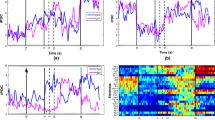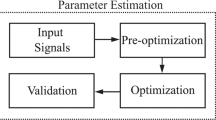Abstract
Exact localization of the epileptogenic zone (EZ) is the first priority for ensuring epilepsy treatments and reducing side effects. The results of traditional visual methods for localizing the origin of seizures are far from satisfactory in some cases. Signal processing methods could extract substantial information that may complement visual inspection of EEG signals. In this study, EZ localization is changed into a driver identification problem, and a nonlinear interdependence measure, the weighted rank interdependence, is proposed and used as a driver indicator because it can detect coupling information, especially directionality, from EEG signals. A proportional integral derivative (PID) controller is then explored, using simulations, to establish its suitability for seizure control. The seizure control we propose rests on identifying the EZ using nonlinear interdependence measures of directed functional connectivity. Two directionally coupled neural mass models are employed for simulation investigation. Two parameters can adjust the sensitivity and completeness of the weighted rank interdependence for different applications, and their effect is discussed in the context of neural mass models. Simulation results demonstrate that use of the weighted rank interdependence for EZ identification can be applied to different EZ types, and the approach achieves an overall identification rate of 98.84 % for several EZ types. Simulations also indicate that PID control can effectively regulate synchronization between neural masses.







Similar content being viewed by others
References
Adam C, Saint-Hilaire JM, Richer F (1994) Temporal and spatial characteristics of intracerebral seizure propagation: predictive value in surgery for temporal lobe epilepsy. Epilepsia 35:1065–1072
Bancaud J, Talairach J, Bonis A, Schaub C, Szikla G, Morel P, Bordas-Ferrer M (1965) La stéréoélectroencéphalographie dans l’épilepsie: informations neurophysiopathologiques apporteées par l’investigation fonctionnelle stereotaxique. Masson, Paris
Bartolomei F, Wendling F, Bellanger JJ, Regis J, Chauvel P (2001) Neural networks involving the medial temporal structures in temporal lobe epilepsy. Clin Neurophysiol 112(9):1746–1760
Bikson M, Fox JE Jr, Jefferys G (2003) Neuronal aggregate formation underlies spatiotemporal dynamics of nonsynaptic seizure initiation. J Neurophysiol 89:2330–2333
Brovelli A, Ding M, Ledberg A, Chen Y, Nakamura R, Bressler SL (2004) Beta oscillations in a large-scale sensorimotor cortical network: Directional influences revealed by Granger causality. Proc Natl Acad Sci USA 101:9849–9854
Buzsáki G (2004) Large-scale recording of neuronal ensembles. Nat Neurosci 7:446–451
Buzsáki G, Draguhn A (2004) Neuronal oscillations in cortical networks. Science 304:1926–1929
Chakravarthy N, Sabesan S, Tsakalis K, Iasemidis L (2009) Controlling epileptic seizures in a neural mass model. J Comb Optim 17:98–116
Chicharro D, Andrzejak RG (2009) Reliable detection of directional couplings using rank statistics. Phys Rev E 80:026217
Cooray GK, Sengupta B, Douglas PK, Friston K (2015) Dynamic causal modelling of electrographic seizure activity using Bayesian belief updating. NeuroImage (in Press)
David O, Cosmelli D, Friston KJ (2004) Evaluation of different measures of functional connectivity using a neural mass model. NeuroImage 21:659–673
David O, Friston KJ (2003) A neural mass model for MEG/EEG: coupling and neuronal dynamics. NeuroImage 20(3):1743–1755
Engel J (1997) Surgical treatment of the epilepsies. Raven Press, New York
Fox JE, Bikson M Jr, Jefferys G (2007) The effect of neuronal population size on the development of epileptiform discharges in the low calcium model of epilepsy. Neurosci Lett 411:158–161
Jansen BH, Rit VG (1995) Electroencephalogram and visual evoked potential generation in a mathematical model of coupled cortical columns. Biol Cybern 73(4):357–366
Jansen BH, Zouridakis G, Brandt ME (1993) A neurophysiologically-based mathematical model of flash visual evoked potentials. Biol Cybern 68(3):275–283
Le Van Quyen M, Martinerie J, Adam C, Varela F (1997) Unstable periodic orbits in a human epileptic activity. Phys Rev E 56:3401–3411
Lehnertz K, Elger CE (1995) Spatio-temporal dynamics of the primary epileptogenic area in the temporal lobe epilepsy characterized by neuronal complexity loss. Electroencephalogr Clin Neurophysiol 95:108–117
Liu X, Gao Q, Li X (2014) Control of epileptiform spikes based on nonlinear unscented Kalman filter. Chin Phys B 23(1):010202
Liu X, Liu H, Tang Y, Gao Q (2013a) Fuzzy PID control of epileptiform spikes in a neural mass model. Nonlinear Dyn 71:13–23
Liu X, Ma B, Ji J, Li X (2013b) Research on UKF control of epileptic-form spikes in neural mass models. J Biomed Eng 30(6):1147–1152 (in chinese)
Ma Z, Zhou W, Geng S, Yuan Q, Li X (2013) Synchronization regulation in a model of coupled neural masses. Biol Cyber 107(2):131–140
Ma Z, Zhou W, Yuan Q, Geng S (2011) Simulation of ictal EEG with a neuronal population model. In: International symposium on bioelectronics and bioinformatics (ISBB 2011), Suzhou, pp 103–106
Murta T, Leal A, Garrido MI, Figueiredo P Dynamic (2012) Causal Modelling of epileptic seizure propagation pathways: a combined EEG-fMRI study. Neuroimage 62(3):1634–1642
Pijn JP, Neerven JV, Noest A, Lopes da Silva FH (1991) Chaos or noise in EEG signals: dependence on state and brain site. Electroencephalogr Clin Neurophysiol 79:371–381
Petkov G, Goodfellow M, Richardson MP, Terry JR (2014) A critical role for network structure in seizure onset: a computational modeling approach. Front Neurol 5:261
Quesney LF, Constain M, Rasmussen T, Stefan H, Olivier A (1992) How large are frontal lobe epileptogenic zones? In: Chauvel P, Delgado-Escueta AV, Halgren E, Bancaud K (eds) Frontal lobe seizure and epilepsies. Raven Press, New York
Quian Quiroga R, Kraskov A, Kreuz T, Grassberger P (2002) Performance of different synchronization measures in real data: a case study on electroencephalographic signals. Phys Rev E 65:041903
Quian Quiroga R, Arnhold J, Grassberger P (2000) Learning driver-response relationships from synchronization patterns. Phys Rev E 61:5142
Sunderam S, Gluckman B, Reato D, Bikson M (2010) Toward rational design of electrical stimulation strategies for epilepsy control. Epilepsy Behav 17(1):6–22
van der Heyden MJ, Velis DN, Hoekstra BP, Pijn JP, van Emde Boas W, van Veelen CW, van Rijen PC, Lopes da Silva FH, DeGoede J (1999) Nonlinear analysis of intracranial human EEG in temporal lobe epilepsy. Clin Neurophysiol 110(10):1726–1740
Wendling F, Badier JM, Chauvel P, Coatrieux JL (1997) a method to quantify invariant information in depth-recorded epileptic seizures. Electroencephalogr Clin Neurophysiol 102:472–485
Wendling F, Bartolomei F, Bellanger JJ, Chauvel P (2001) Interpretation of interdependencies in epileptic signals using a macroscopic physiological model of the EEG. Clin Neurophysiol 112(7):1201–1218
Wendling F, Bartolomei F, Bellanger JJ, Chauvel P (2002) Epileptic fast activity can be explained by a model of impaired GABAergic dendritic inhibition. Eur J Neurosci 15(9):1499–1508
Wendling F, Bellanger JJ, Bartolomei F, Chauvel P (2000) Relevance of nonlinear lumped-parameter models in the analysis of depth-EEG epileptic signals. Biol Cybern 83(4):367–378
Wendling F, Hernandez A, Bellanger JJ, Chauvel P, Bartolomei F (2005) Interictal to ictal transition in human temporal lobe epilepsy: insights from a computational model of intracerebral EEG. J Clin Neurophysiol 22(5):343–356
Acknowledgments
This work was supported by the Development Program of Science and Technology of Shandong (No. 2014GSF118171), and the Fundamental Research Funds of Shandong University (No. 2014QY008).
Author information
Authors and Affiliations
Corresponding author
Appendix
Appendix
Proposition
\(H^{(k,a)}(X|Y)\in (0,1]\).
Proof
By definition, both \(G_n^{(k,a)} (X)\) and \(G_n^{(k,a)} (X|Y)\) are greater than 0, so \(H^{(k,a)}(X|Y)\) is greater than 0. If X is consistent with Y, that is, \(G_n^{(k,a)} (X)=G_n^{(k,a)} (X|Y)\) \((n=1,2,\ldots ,N)\), then \(H^{(k,a)}(X|Y)=1\).
If X is not consistent with Y, two situations occur: The k nearest neighbors of \({\mathbf {y}}_n \) are the k nearest neighbors of \({\mathbf {x}}_n \), or the k nearest neighbors of \({\mathbf {y}}_n \) are not the k nearest neighbors of \({\mathbf {x}}_n \).
If the k nearest neighbors of \({\mathbf {y}}_n \) are the k nearest neighbors of \({\mathbf {x}}_n \), that is, \(g_{nr_{n,j} }^X =j\) for \(j=1,2,\ldots ,k\) and \(g_{ns_{n,j} }^X \in \{1,2,\ldots ,k\}\), but \(g_{ns_{n,j} }^X \) is not necessarily equal to j. \(g_{ns_{n,j} }^X \) can become \(g_{nr_{n,j} }^X \) after a sorting process realized via a sorting algorithm such as bubble sorting. In the bubble sorting algorithm, two adjacent elements are compared; if the former is greater than the latter, they switch positions, and otherwise they maintain their positions. This task is repeated for every pair of adjacent elements. After a comparison, if the positions remain unchanged, then \(G_n^{(k,a)} (X|Y)\) is unchanged; if the elements are switched (e.g., if \(g_{ns_{{n,j}_1}}^X \) and \(g_{ns_{{n,j}_2}}^X\) are exchanged), then the change in \(G_n^{(k,a)} (X|Y)\) is \(-(g_{ns_{{n,j} _1}}^X -g_{ns_{{n,j}_2}}^X )\)*\((a^{n_{j_1} }\hbox {-}a^{n_{j_1} +1})<\)0, and therefore \(G_n^{(k,a)} (X|Y)\) will be unchanged or will become smaller. After \(\frac{k(k-1)}{2}\) comparisons, \(G_n^{(k,a){\prime }} (X|Y)=G_n^{(k,a)} (X)<G_n^{(k,a)} (X|Y)\), and therefore \(H^{(k,a)}(X|Y)<1\).
If the k nearest neighbors of \({\mathbf {y}}_n \) are not the k nearest neighbors of \({\mathbf {x}}_n \), a series of switches can yield the situation discussed above, whereby the k nearest neighbors of \({\mathbf {y}}_n \) are the k nearest neighbors of \({\mathbf {x}}_n \). Each switch is performed between \(g_{ns_{{n,j}_3}}^X >k \) and \(g_{ns_{{n,j}_4}}^X <k\), and the change in \(G_n^{(k,a)} (X|Y)\) is \(-(g_{ns_{{n,j}_3}}^X -g_{ns_{{n,j}_4} }^X )\)*\(a^{n_{j_3}}\). In this case, we can still obtain \(G_n^{(k,a)^{\prime }} (X|Y)=G_n^{(k,a)} (X)<G_n^{(k,a)} (X|Y)\), and therefore \(H^{(k,a)}(X|Y)<1\). \(\square \)
Rights and permissions
About this article
Cite this article
Ma, Z., Zhou, W., Zhang, Y. et al. Epileptogenic zone localization and seizure control in coupled neural mass models. Biol Cybern 109, 671–683 (2015). https://doi.org/10.1007/s00422-015-0667-1
Received:
Accepted:
Published:
Issue Date:
DOI: https://doi.org/10.1007/s00422-015-0667-1




